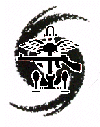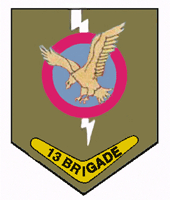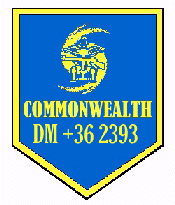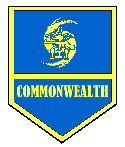|
Nous Voila was never occupied by the Kafers but the world was blockaded and subjected to routine, genocidal bombardment of population centres and random raiding from orbit. The colony's infrastructure largely collapsed under the strain and civilisation began to fray at the edges with widespread barbarism becoming commonplace. The French led Liberation had to concentrate on restoring order with more and more infantry soldiers having to flood into the colony to impose control. The Commonwealth forces were asked to provide forces to aid in this mission and a brigade of Anglo-Dutch Royal Marines was dispatched.
Adlerhorst was never taken by the Kafers during the Invasion campaign and was used throughout as the base of operations for Admiral Rochemont's Fleet. It is still a major logistical centre for operations out to Eta Bootis, as well as hosting most of the American and French reaction forces. Commonwealth participation in the Fleet based at Adlerhorst is generally restricted to British and Australian space naval squadrons. However the main body of the Australian Expeditionary Force has been deployed to the system. The Commonwealth participation in the peacekeeping mission to Adlerhorst has fallen into abeyance since the creation of the Joint Vogelheim Brigade from the peacekeepers during the Invasion. That famous brigade has since been disbanded and with the improved relations between French and German colonists the need for a replacement has been put on hold. Only a nominal staff keeps the mission ticking over for Americans, British and Canadians. However Australia, always aware of its peacekeeping commitments, has sent a replacement battalion to the world. Parts of this battalion have since been appropriated for other tasks including a deployment to Dunkelheim.
The Commonwealth Contingent to Dunkelheim is a light force undertaking more of a political-diplomatic task than a strictly military one. Although some mopping up operations are continuing on Dunkelheim most activity is humanitarian and defensive in nature. The colony remains one of the most vulnerable colonies to a Kafer counter-attack, so human forces led by Germany and America are preparing a defence in depth for the world despite the difficulties of combat operations on this arid planet. Commonwealth troops are present to aid all three facets of this plan although the UK regards the colony as poorly defensible and its troops are prepared for possible guerrilla operations.
The troubled British colony world of Crater in the Henry's Star system was assaulted and occupied by the Kafers during the Invasion. However successful guerrilla operations kept the Kafers on the back foot until Liberation by Rochemont's Fleet. Unfortunately the Kafers had only been pushed back into concealed fortifications in the arid Dayside and it took a substantial deployment of regular British troops to suppress the situation. However even now some limited fighting still takes place on the Dayside. Conventional military defence of the colony in the face of enemy orbital supremacy is though to be almost impossible due to the centralisation of infrastructure in the vulnerable city of Rimview. However guerrilla operations are very viable and any long term defence is based around this style of operation and deep supply dumps have been established at the various mine complexes. Much needed political and law reforms in the colony have also lessened the pre-war tension in the colony and internal security duties are much less frequent.
Joi was the last human colony world to be hit in the Kafer Invasion, however the assault was disrupted by the arrival of Rochemont's Fleet, but not before many thousands of Kafer troops had been landed on Japanese and German colonies. Mopping up operations against took some considerable time and were of no little ferocity in spite of the lack of coverage in the media. Today some Kafer guerrillas still operate in the backwoods of the German colony. However the threat from the Kafers has largely receded from the public perception and international and inter-colonial rivalries have surged to the fore again. Southern Defence Command Britain's New Cornwall and Azania's Lubumbashi colonies are collocated on the same southern continent and have long enjoyed a close working relationship, with the larger Azania colony making much use of the excellent British infrastructure. In the aftermath of the Invasion these two ESA and Commonwealth partners have decided to pool defensive resources and infrastructure. This has resulted in the formation of the Southern Defence Command, a tri-service body jointly controlling all military assets on the continent. Although not yet fully operational the initial signs are good. The Command controls 3 manoeuvre brigades in addition to air forces, coast guard, militia and civil defence forces.
Alicia Alicia is home to the CEF HQ and much of the panoply and rear area units that makes combat operations by Commonwealth forces further up-Arm possible. It was also very vulnerable to Kafer assault, a threat that was only averted by the success of the Battle of Beowulf. All Alician forces fall under the aegis of the CEF and two brigades and a number of independent units have been made available for operations off Alicia. One of these brigades is on Beta Canum as part of the Commonwealth Armoured Division. Alicia's military is still a volunteer force, although membership of the volunteer reserves has become almost compulsory through social pressure alone. Alicia's regulars are regarded as excellent fighting troops, especially due to their night fighting proficiency and more troops may be requested for service up-Arm. Alicia's conservative outlook has allowed the Dominion Government to harness virtually the whole of the economy to the war effort. Alician public opinion is greatly in favour of continuing operations against the Kafers at a high intensity both for reasons of prestige but also as they are aware of how vulnerable they could be against a renewed Kafer offensive. Australia Australia was one of the first nations to send a small expeditionary force to aid the human forces at Eta Bootis, and retains the policy of sending small but potent units to fight on the French Arm. The self-sufficiency of these units has greatly eased the CEF's starlift constraints. At the height of the Liberation the Australian Expeditionary Force had three brigades in theatre, but this has since reduced to an assault brigade at Alderhorst and an armoured brigade in reserve at Alicia. Australia also has commitments at the 'Backdoor' of the American Arm. Azania Azania was hit hard by the Invasion loosing her colony at Kimanjano after a prolonged defence and being cut off from its territory at Joi. However they responded quickly with mechanised and marine brigades being deployed to Beowulf along with units from Azania's southern African allies. Azanian troops were prominent in the Liberation of Kimanjano and other forces sent to ensure the security of the colony on Joi. Currently Azania deploys some 6 combat brigades on its colony worlds in the upper French Arm in addition to an 'International' brigade on Beta Canum. The forces on Kimanjano are integrated into the French led-command structure. Bombay Bombay became involved in the project to create an International Brigade from the Indian sub-continent and contributed the prestigious 1st Armoured Regiment to the unit. Successors to the famous Hodson's Horse of the old Indian Army the unit prizes its history and traditions whilst also being very proficient with their Cavalier hovertanks. Britain Britain had some 6 regular combat brigades in the Beta Canum cluster at the time of the Invasion with more armoured reinforcements on the way. However these reinforcements were trapped at the Beowulf bottleneck and unable to intervene as one by one the British colonies were assaulted and occupied by the Kafers. The British became one of the leading proponents of the CEF and provided much of the shipping and logistical back up. They also used their enforced pause at Beowulf wisely, configuring II Corps for the forthcoming operations. They now deploy some 13 combat brigades and numerous higher formation HQ's in the area, some 45% of the regular army's combat brigades. Although overstretch is becoming a problem the British are keen to wipe out the stigma of having their colonies overrun. Britain is a leading player and prefers a more defensive strategy than the other major nations, fearing a disaster should humanity make a premature strike into Kafer territory. Canada Most of Canada's colonial holdings and interests reside in the Chinese Arm, however the Canadians were swift to offer part of her small regular forces for service on the French Arm. A battalion of the Canadian Airborne Regiment was soon dispatched alongside a small space naval squadron and an armoured brigade underwent a substantial period of training and re-equipment before deployment. The Canadian brigade was accompanied by its own integral starlift capacity so like the Australians had enhanced strategic mobility. The Canadians have mainly fought on Beta Canum and have added to their historic reputation as expeditionary soldiers. The Canadian government has settled on a long term deployment of Armoured Brigade for at least another two years and has continued rotating key personnel. 1 CAR has since returned to Earth. Crater Crater continues to concentrate on the campaign to root out the last Kafers from the planet's surface. The planet's small population, harsh conditions and vulnerability limit the size of the defence forces, and many mercenary soldiers find service in the ranks of the Crater's military. Despite (or perhaps because of) the social problems of the colony the Craterans have found in themselves a natural ability as guerrilla fighters. India Along with Bombay, India was a prime mover in the attempt to create an International Brigade from the sub-continent, partly for reasons of political prestige. India contributed a battalion of their Guards as well as a substantial part of the brigade staff and combat support assets. Kenya Kenya were late participants to the East African International Brigade, contributing a battalion of the Kenyan Rifles. Lacking the prolonged build up of the Malawi and Tanzanian contingents the battalion took some time to work up and get used to internal brigade procedures. However the unit is now well integrated and benefits from regular replacement drafts of troops. Malawi Along with Tanzania Malawi was one of the pioneers of the International Brigade concept. However the difficulties of deploying and sustaining such a formation have disillusioned the Malawi government somewhat. However there are still some 1500 Malawian troops deployed under the Commonwealth aegis providing useful service in spite of the logistical difficulties. Netherlands Although not a member of the Commonwealth the Netherlands was quick to offer troops for service on the French Arm alongside its British allies. This originally came in the form of a squadron of the 1st Armoured Recce Battalion 'Huzaren Prins van Oranje' attached to 7 Armd Bde and a battalion from the Royal Netherlands Marine Corps attached to 4 Cdo Bde, RM. Later the Dutch government also offered its crack Guards assault infantry battalion, which was gratefully accepted into 1 Armd Bde. These troops have seen some action and generally have integrated well into the British formations. Casualties have not been high and public support for Dutch participation in the conflict remains high. However with the stalling of the military campaign one of the battalions may be withdrawn back to Earth. Nepal Nepalese Gurkhas in British service have seen fierce action against the Kafers. However the Nepalese government has also underwritten the deployment of a mercenary Independent Gorkha battalion as a part of the Indian Brigade on Beta Canum. Recruiting restrictions on the British have also been lifted. New Africa New Africa on Beta Canum-4 was the site of much vicious fighting, loosing at least half a million of the pre-war population, but was never completely occupied by the Kafers. In the post-War period the New Africa Defence Force has been rationalised and revitalised with a re-equipment program and the introduction of compulsory National Service. All of the NADF comes under the aegis of the CEF and its combat forces have gained a reputation for the aggressiveness, efficiency and ruthlessness of its light infantry soldiers. New Africa is in favour of immediate retaliatory operations into Kafer space. New Zealand Elements of the New Zealand Army were serving with the Vogelheim Peacekeepers as part of the Australian contingent and saw action with the Joint Vogelheim Brigade. Members of the NZSAS on secondment to 24 SAS were also in theatre. However the NZ government decided to provide a battalion sized light infantry Battlegroup for service on the French Arm. Drawn from volunteers from across the NZ Army this volunteer formation was named the Tarakiwa Rangers, after the Maori God of War. The Tarakiwa Rangers soon proved an excellent unit and were attached on arrival in theatre to 1 Light Div, where they remain as the close recce element in the DRG. Punjab The Punjabi government was a reluctant participant in the Indian International Brigade, however it agreed to provide a contingent rather than loose face. It's battalion of Sikh soldiers are well disciplined troops with a proven eagerness to get to grips with the Kafers. Tanzania Tanzania was initially a major mover behind the original International Brigade. Contributing two infantry battalions but a subsequent change of government has led the contribution to be increasingly poorly supported from Earth and the two battalions have been forced to ammalgamate into one. There is a possibility that Tanzania may withdraw from the brigade entirely. Wellon Wellon is a key player in the Commonwealth and has been a enthusiastic supporter of the CEF concept. The Wellonese Army has provided 3 combat brigades and a divisional HQ. Considering that this is the Wellon's first major operation they have acquitted themselves well and the deployment is hugely popular at home. Wellon largely holds the same strategic and diplomatic opinions as the British and there is little disagreement between the two. |



